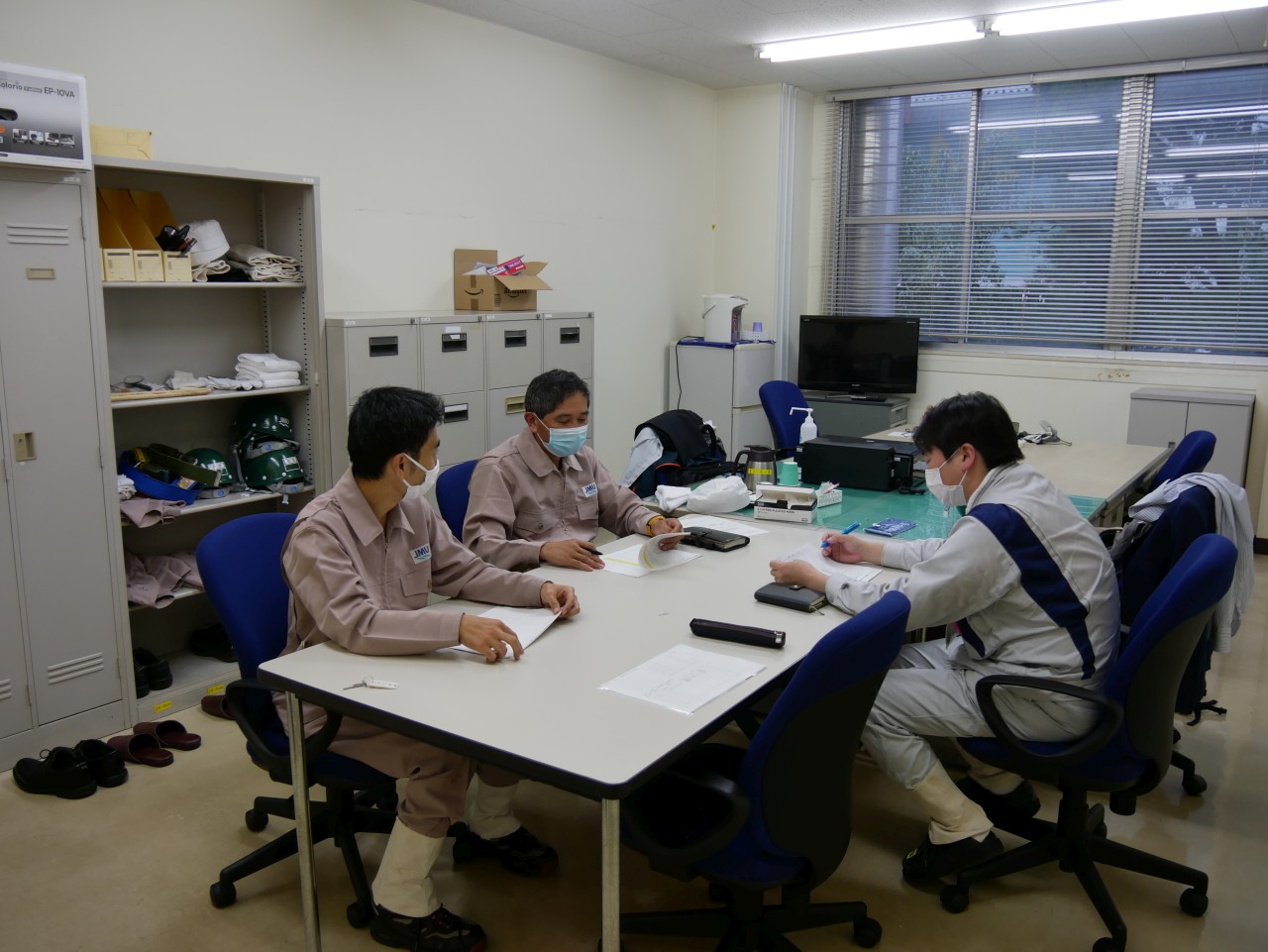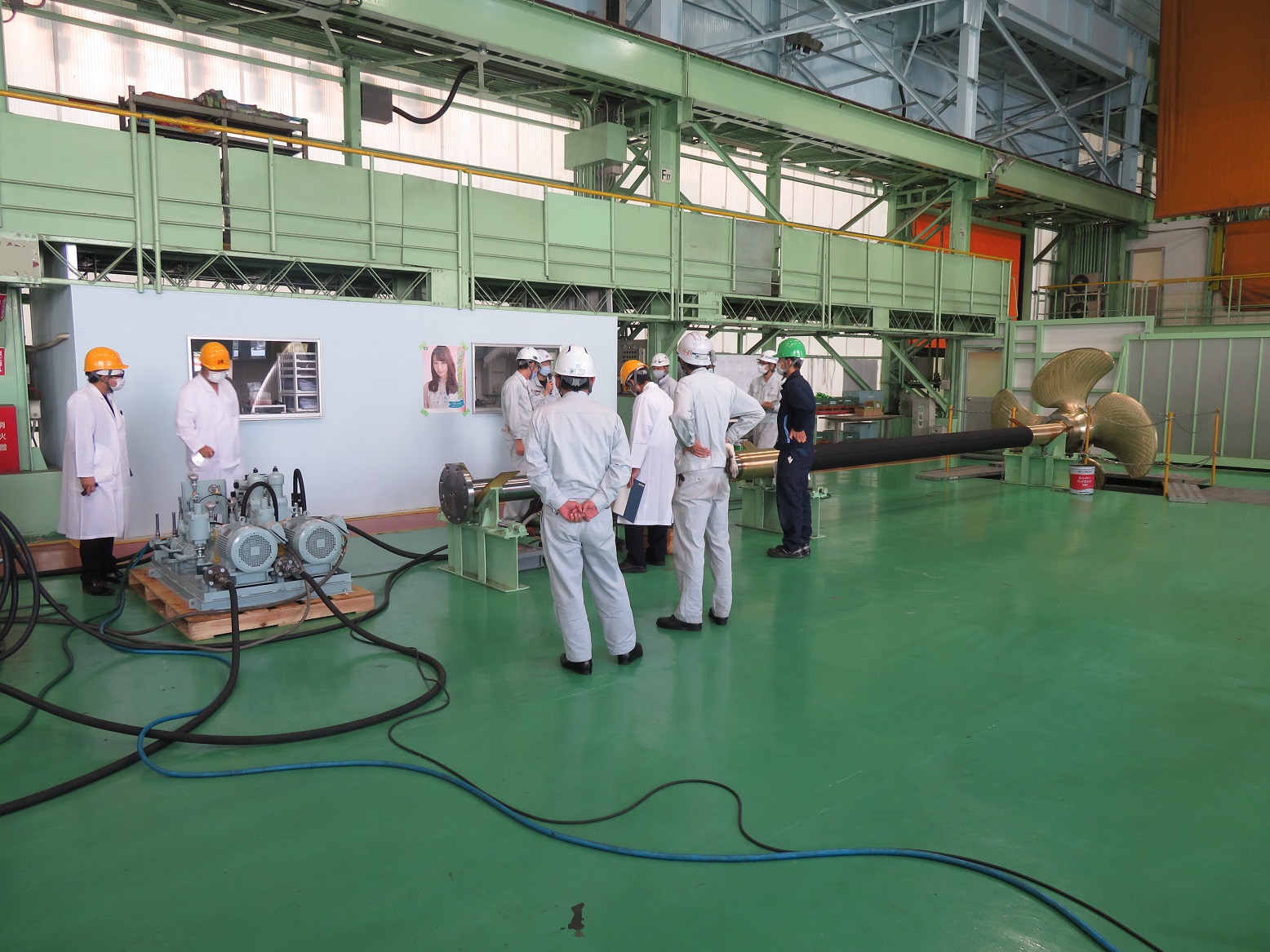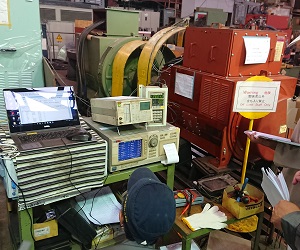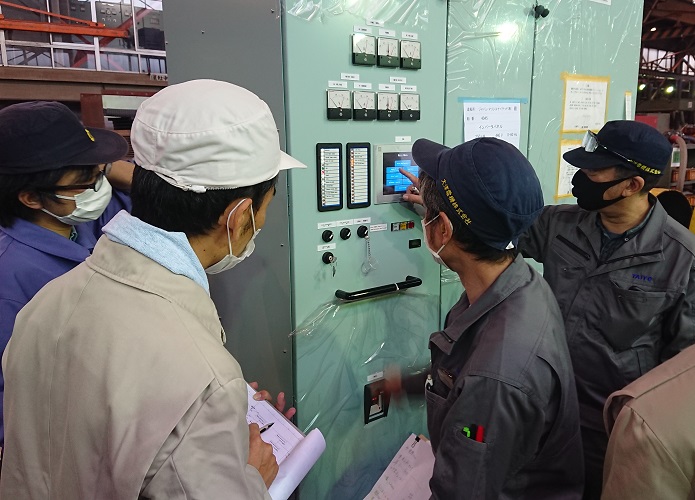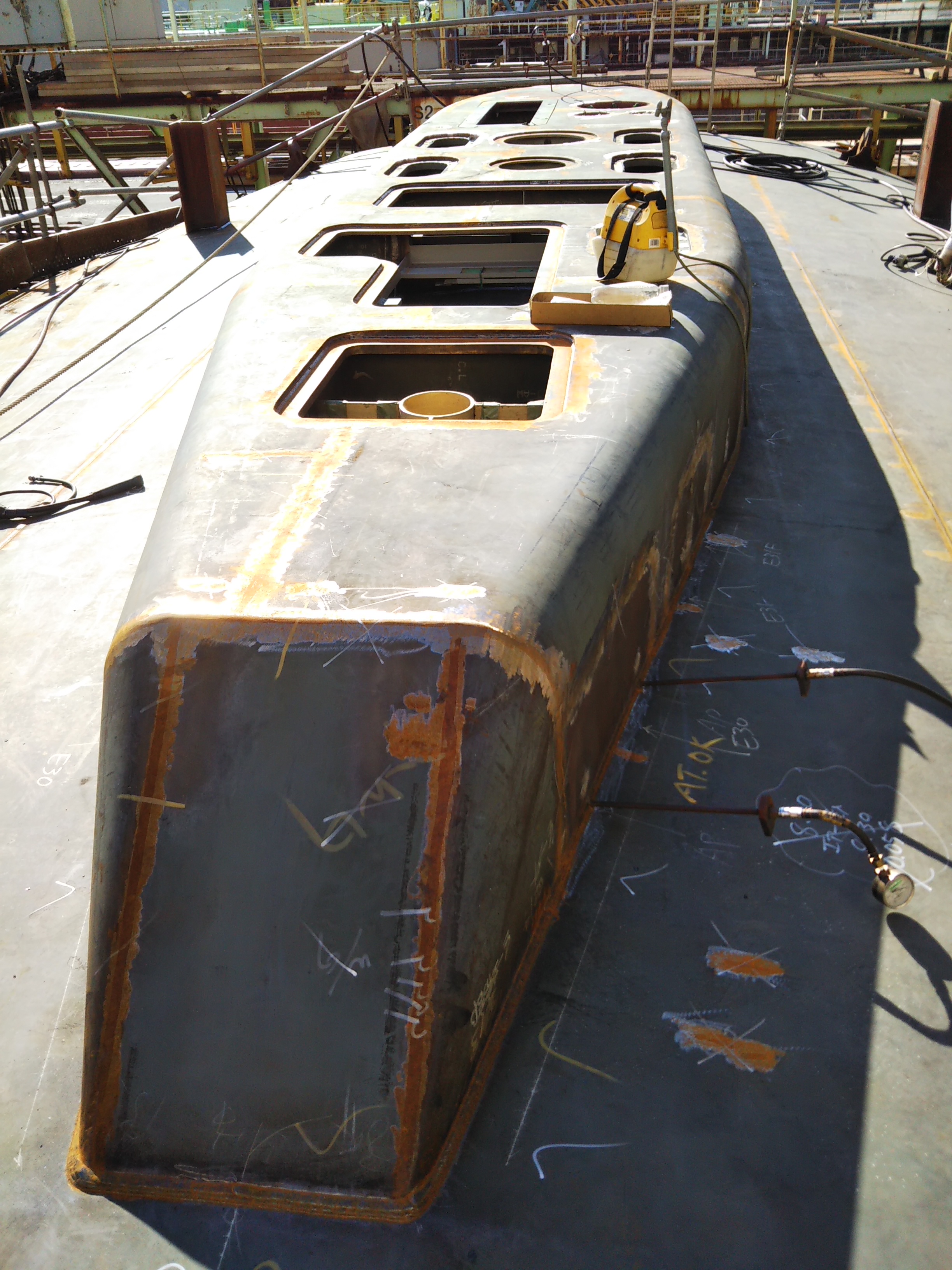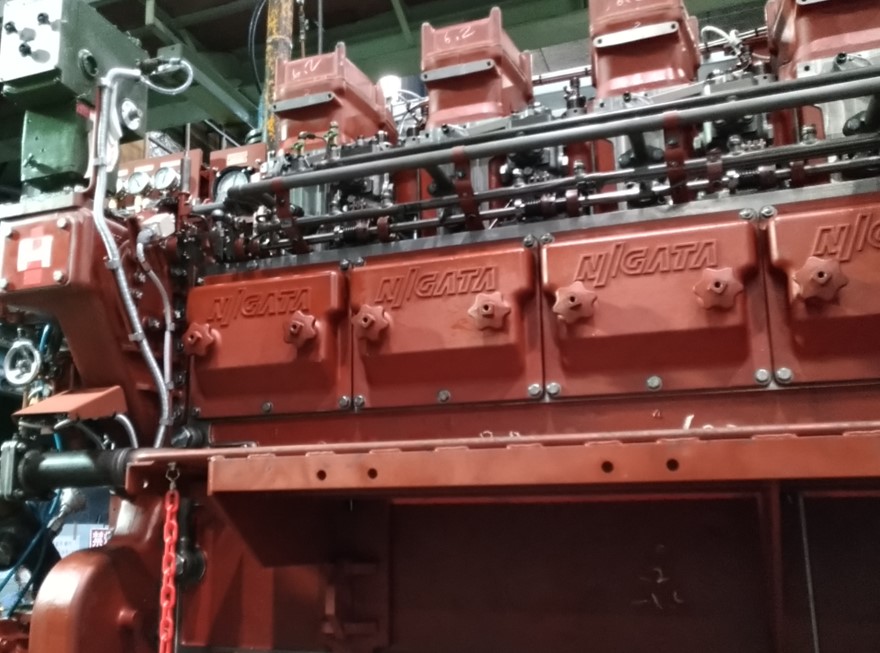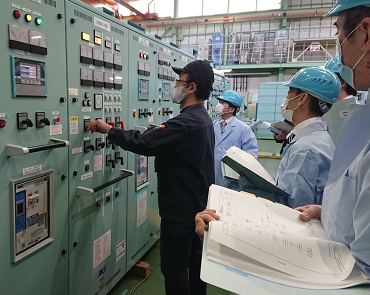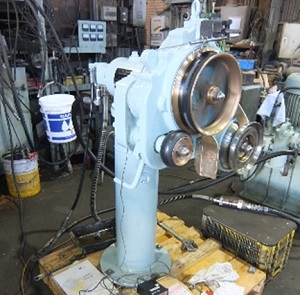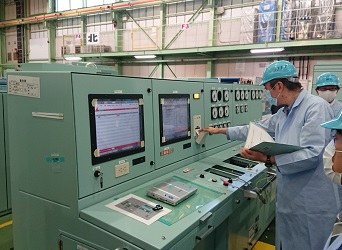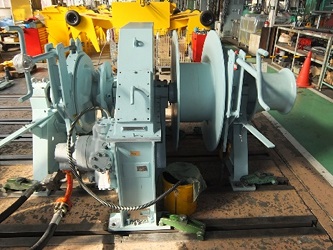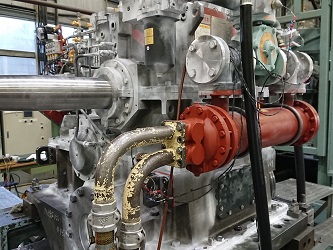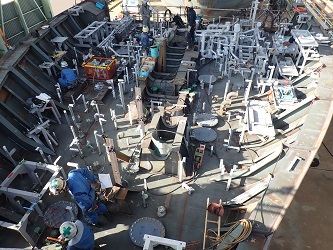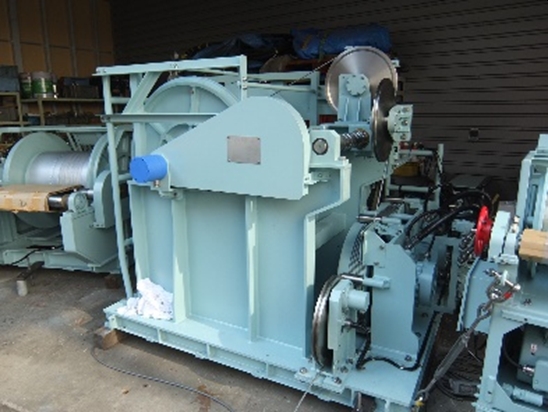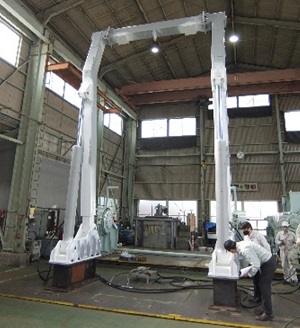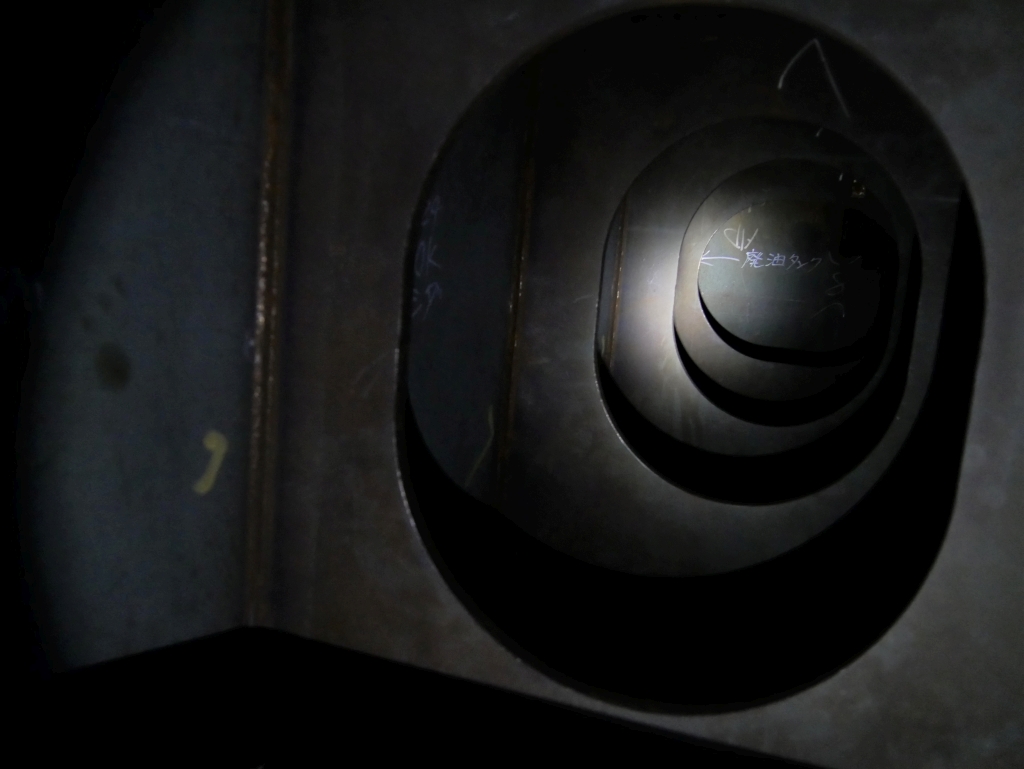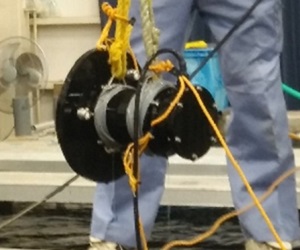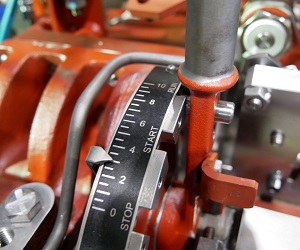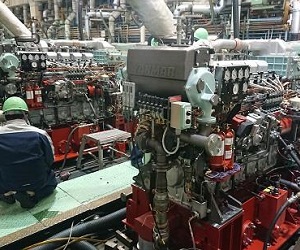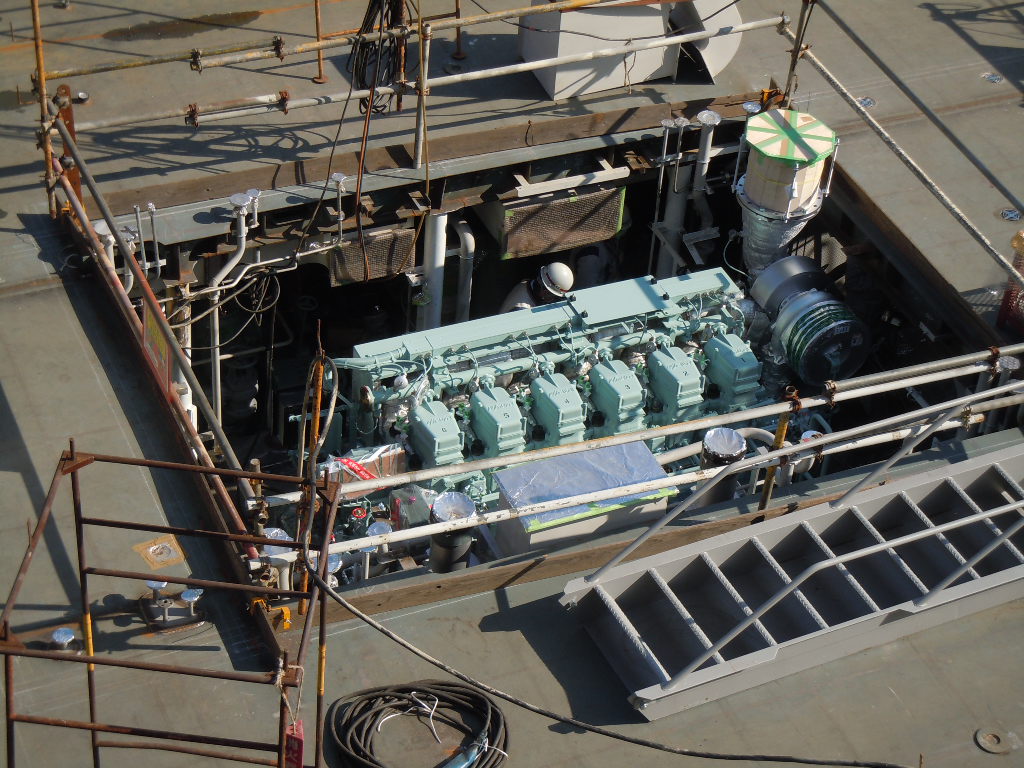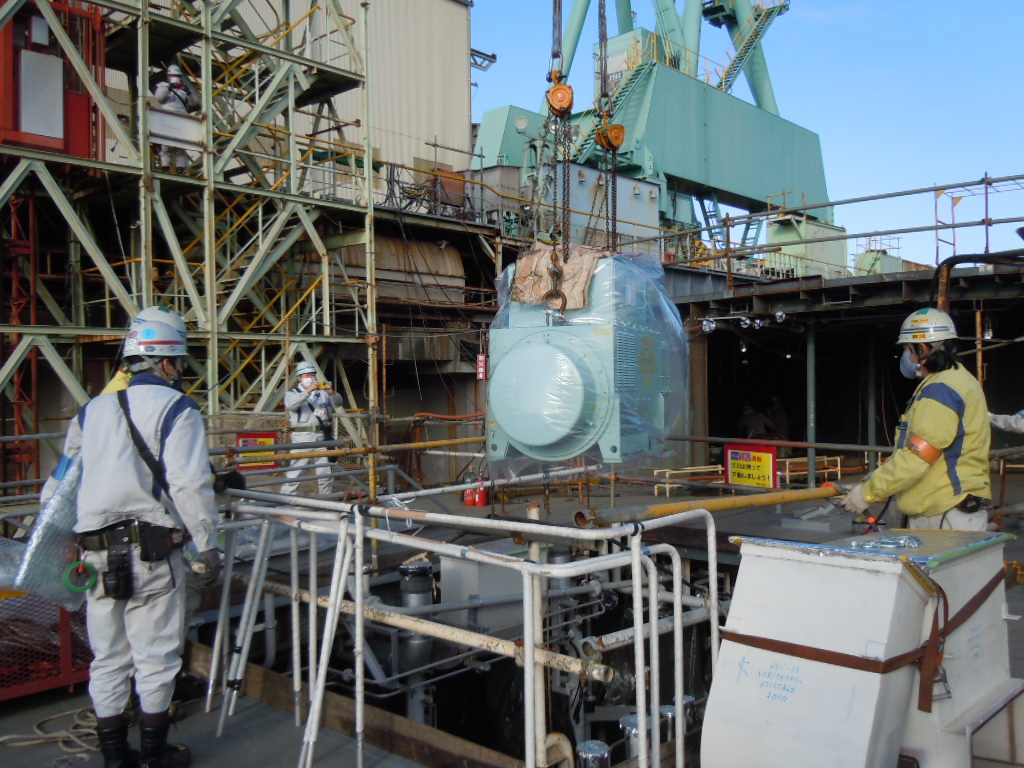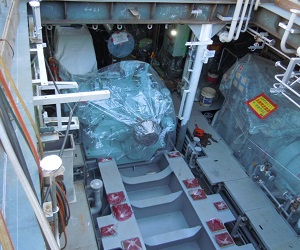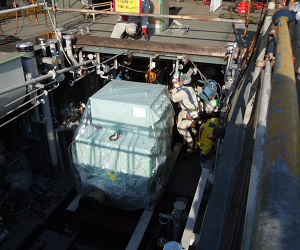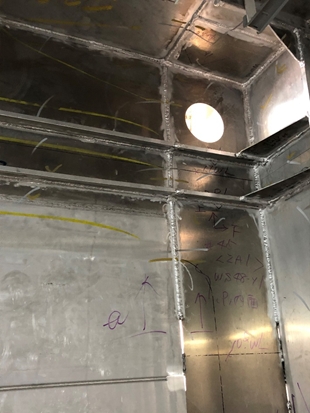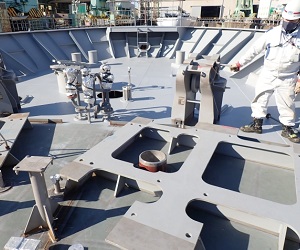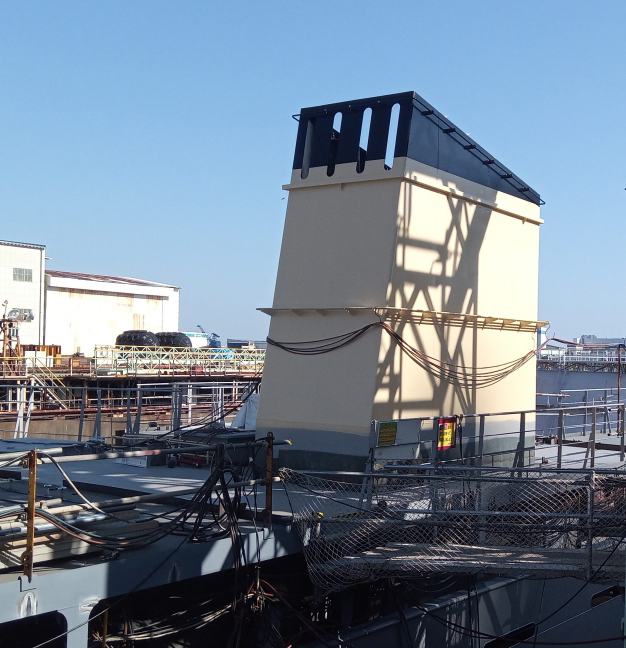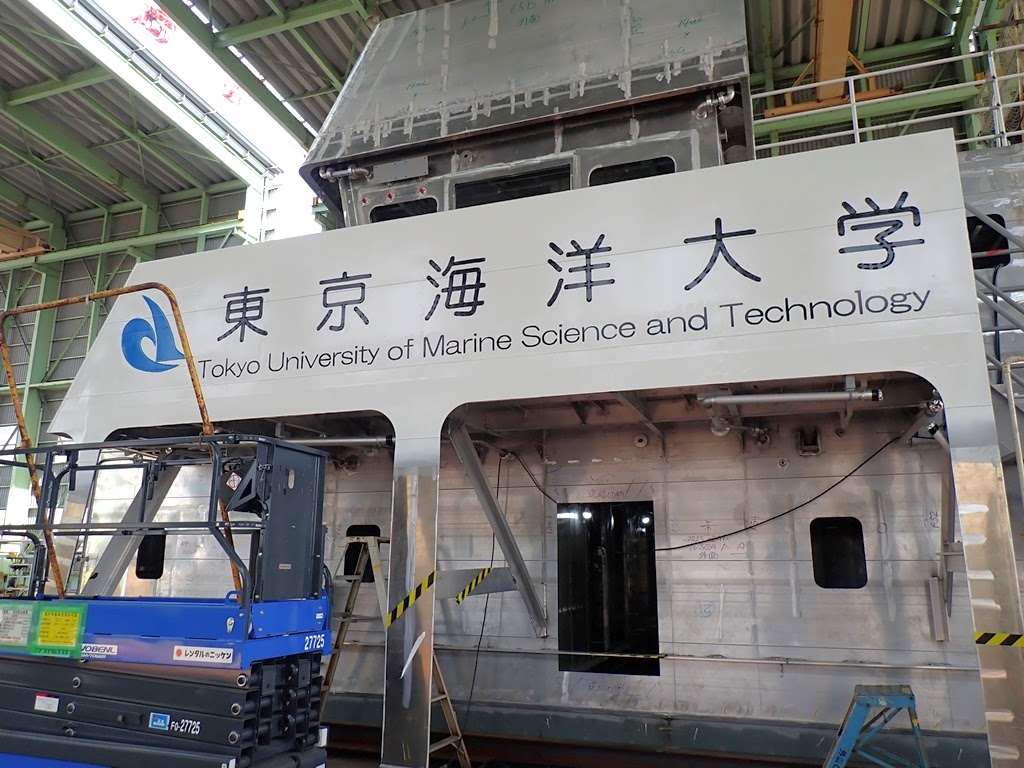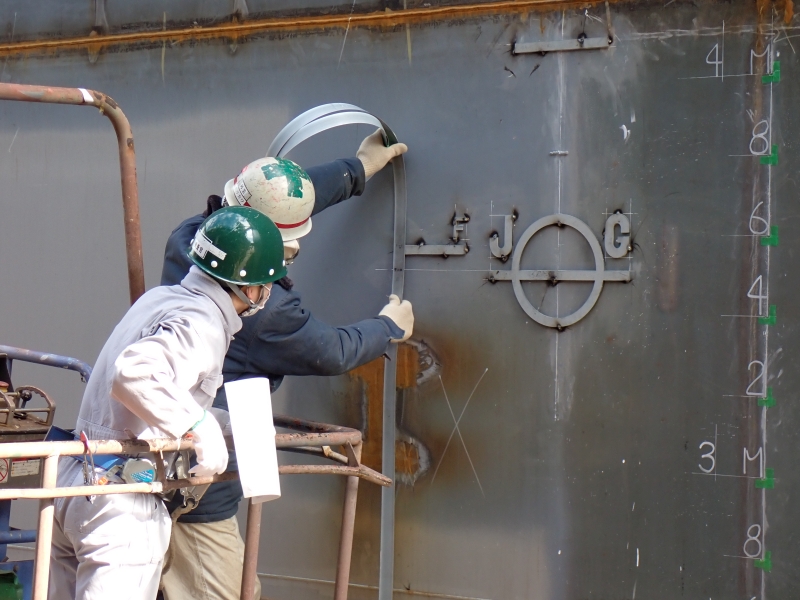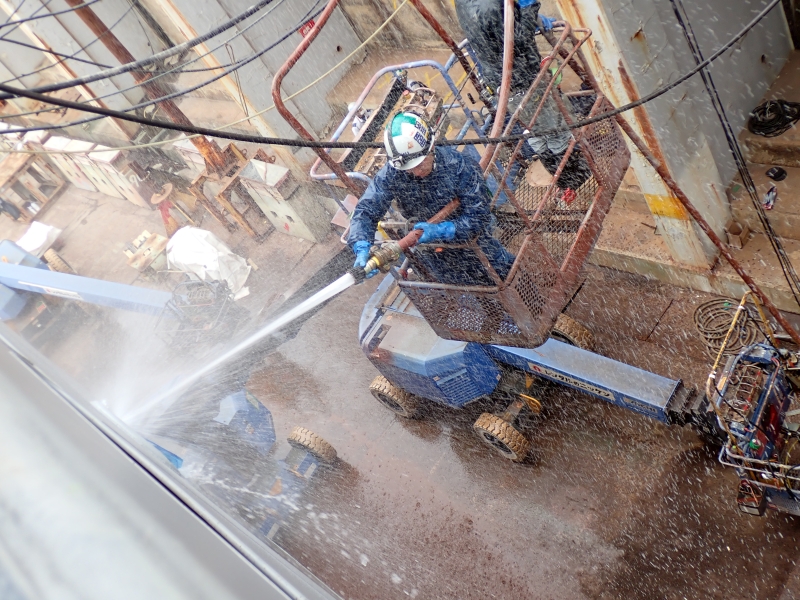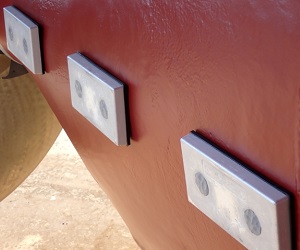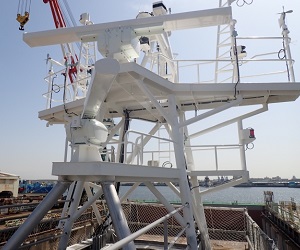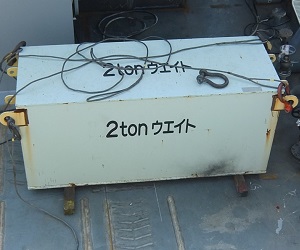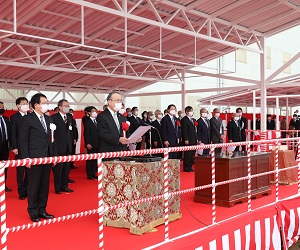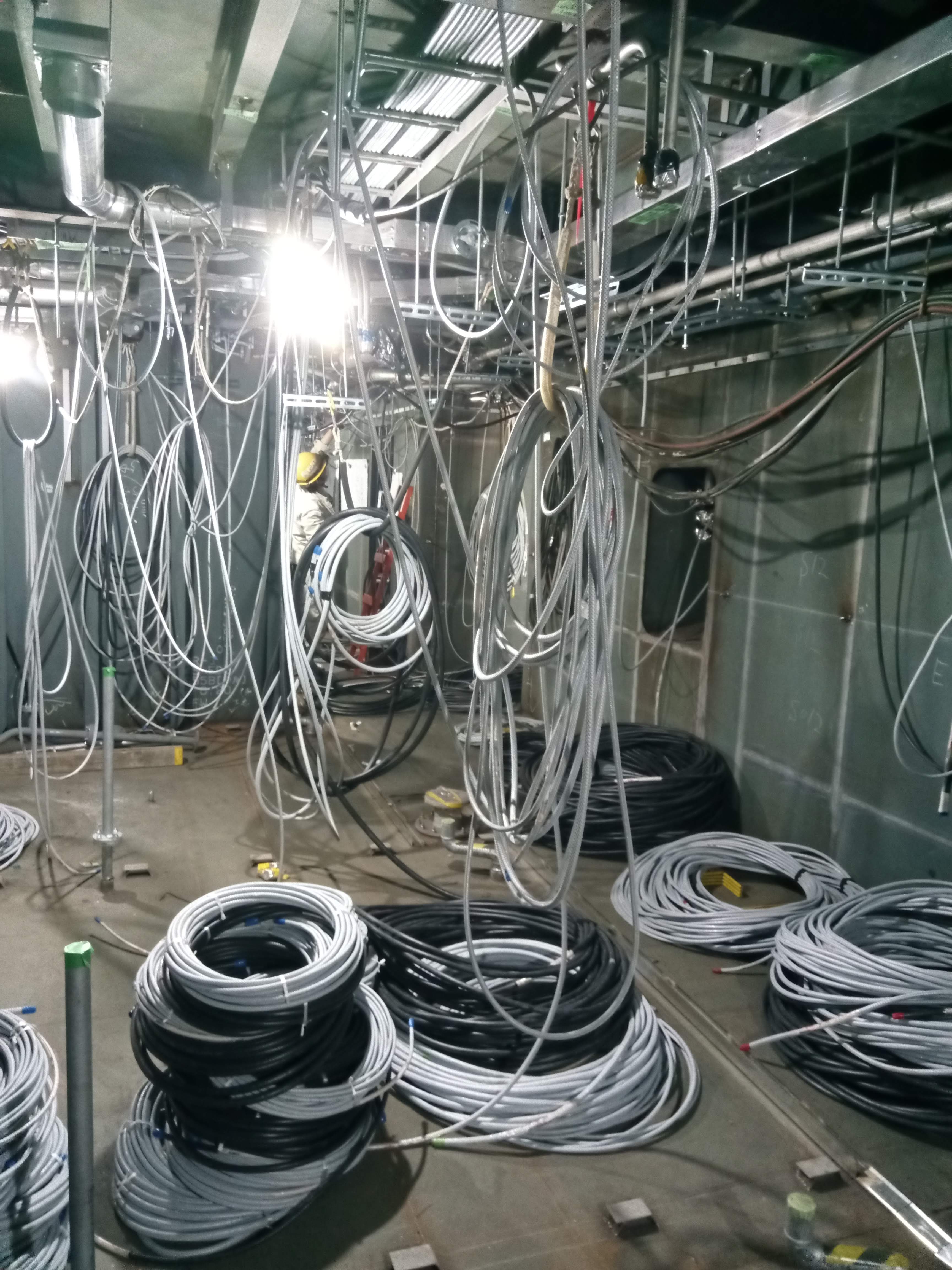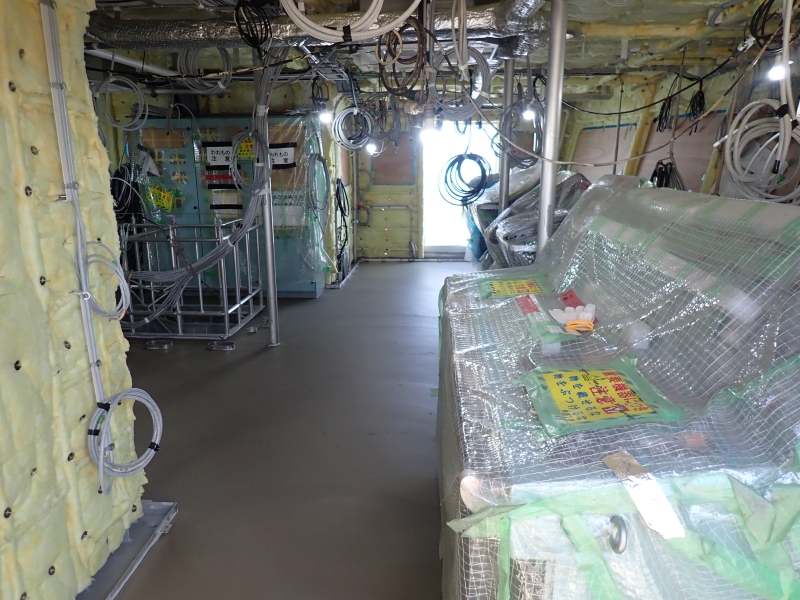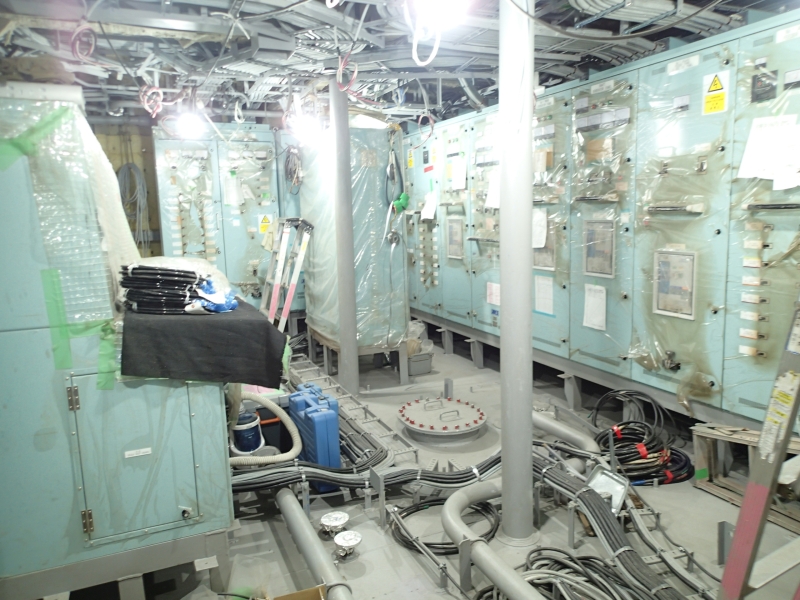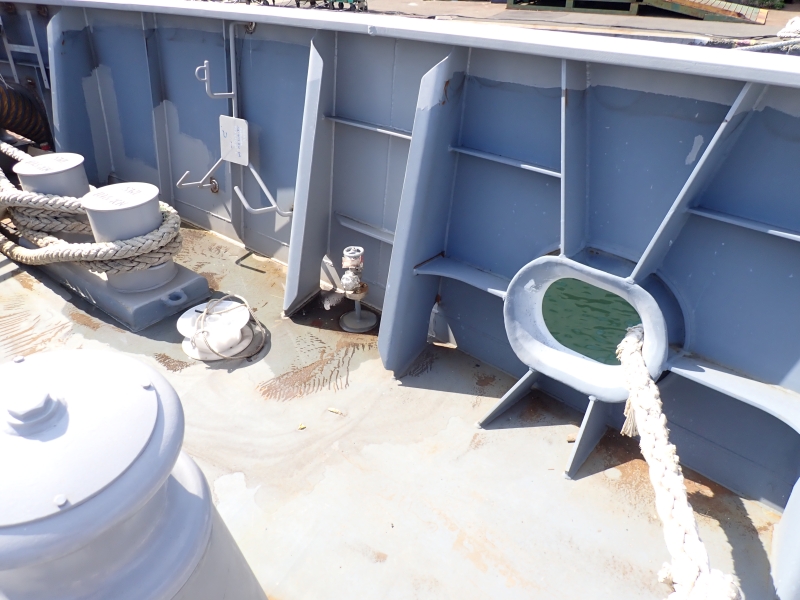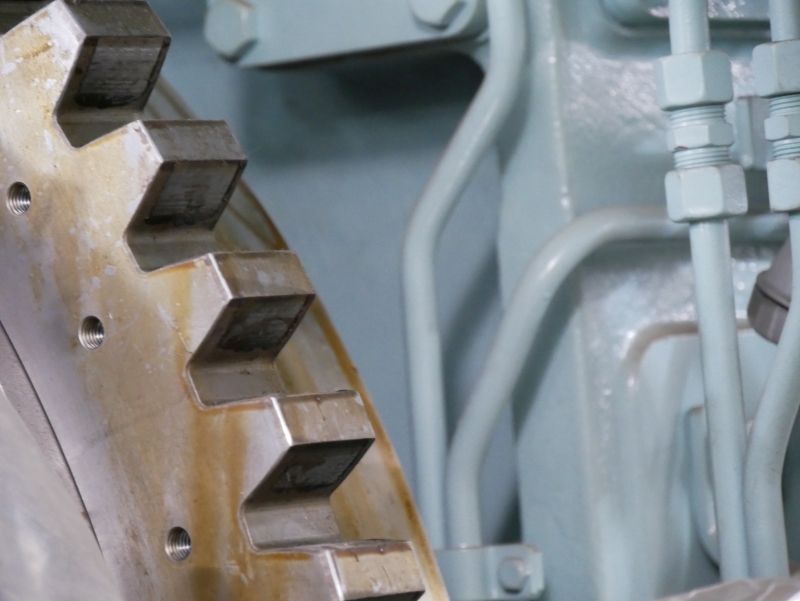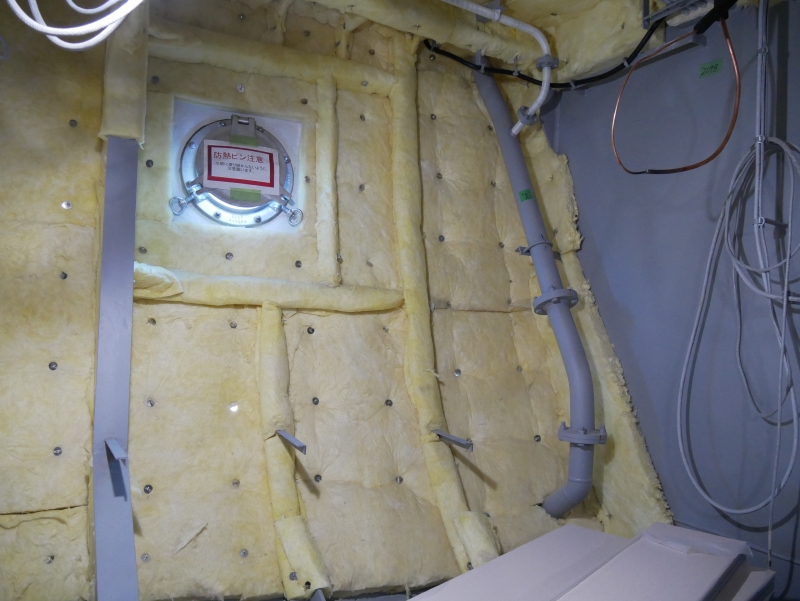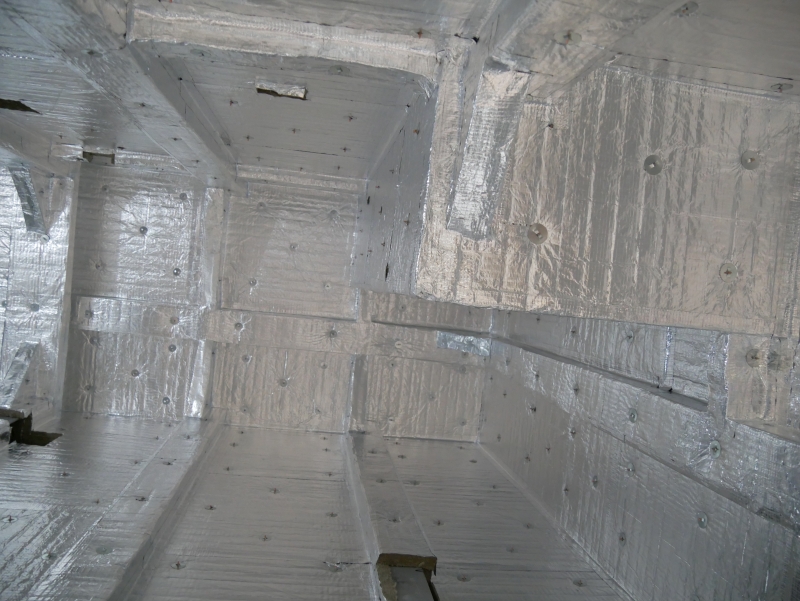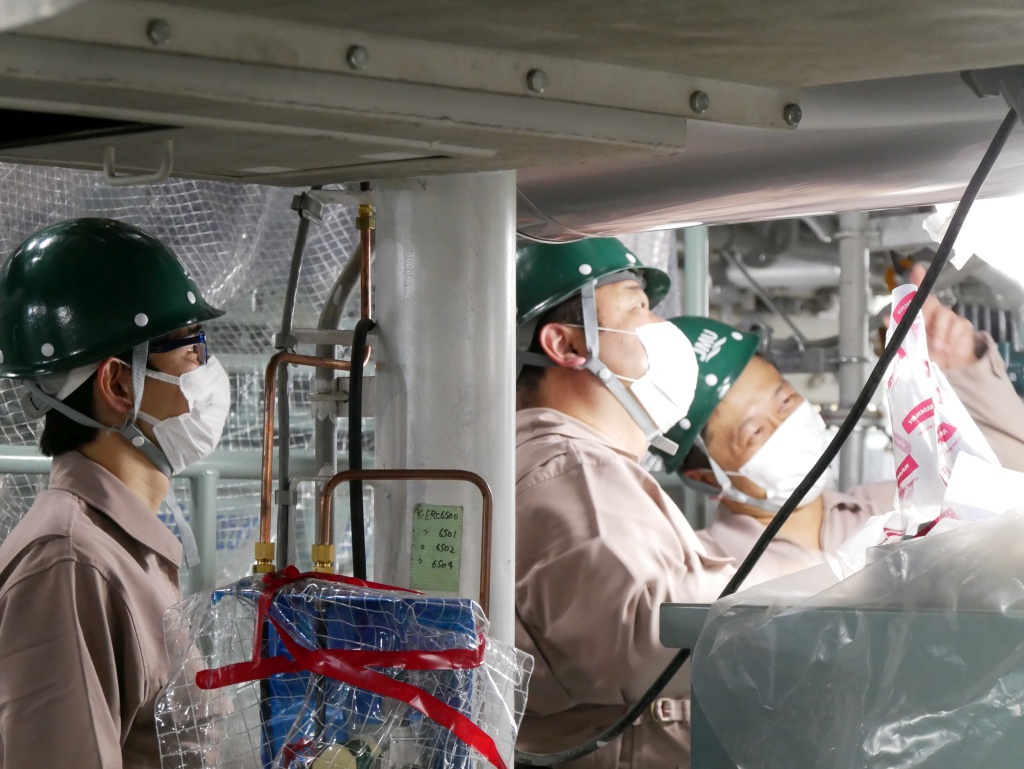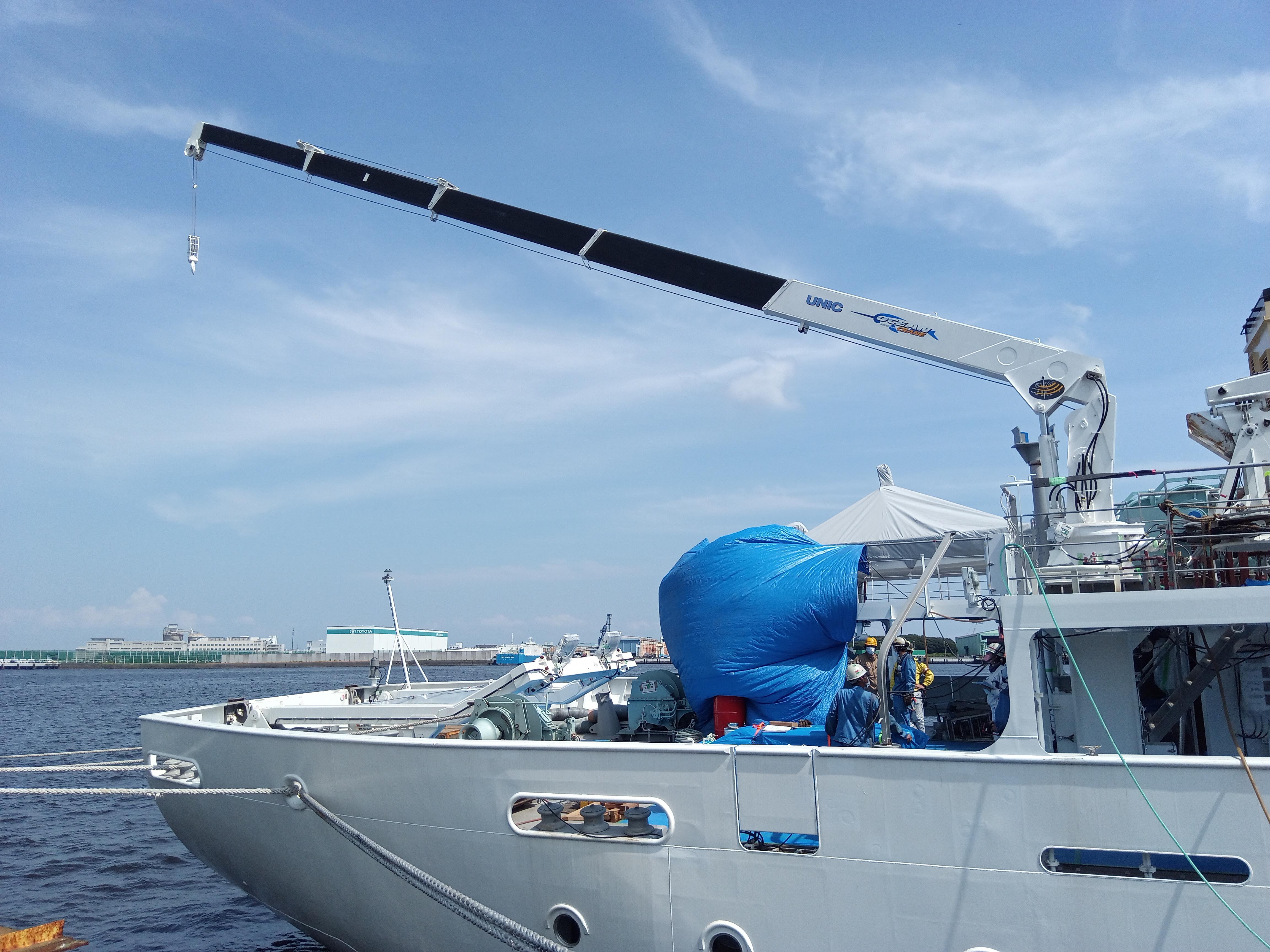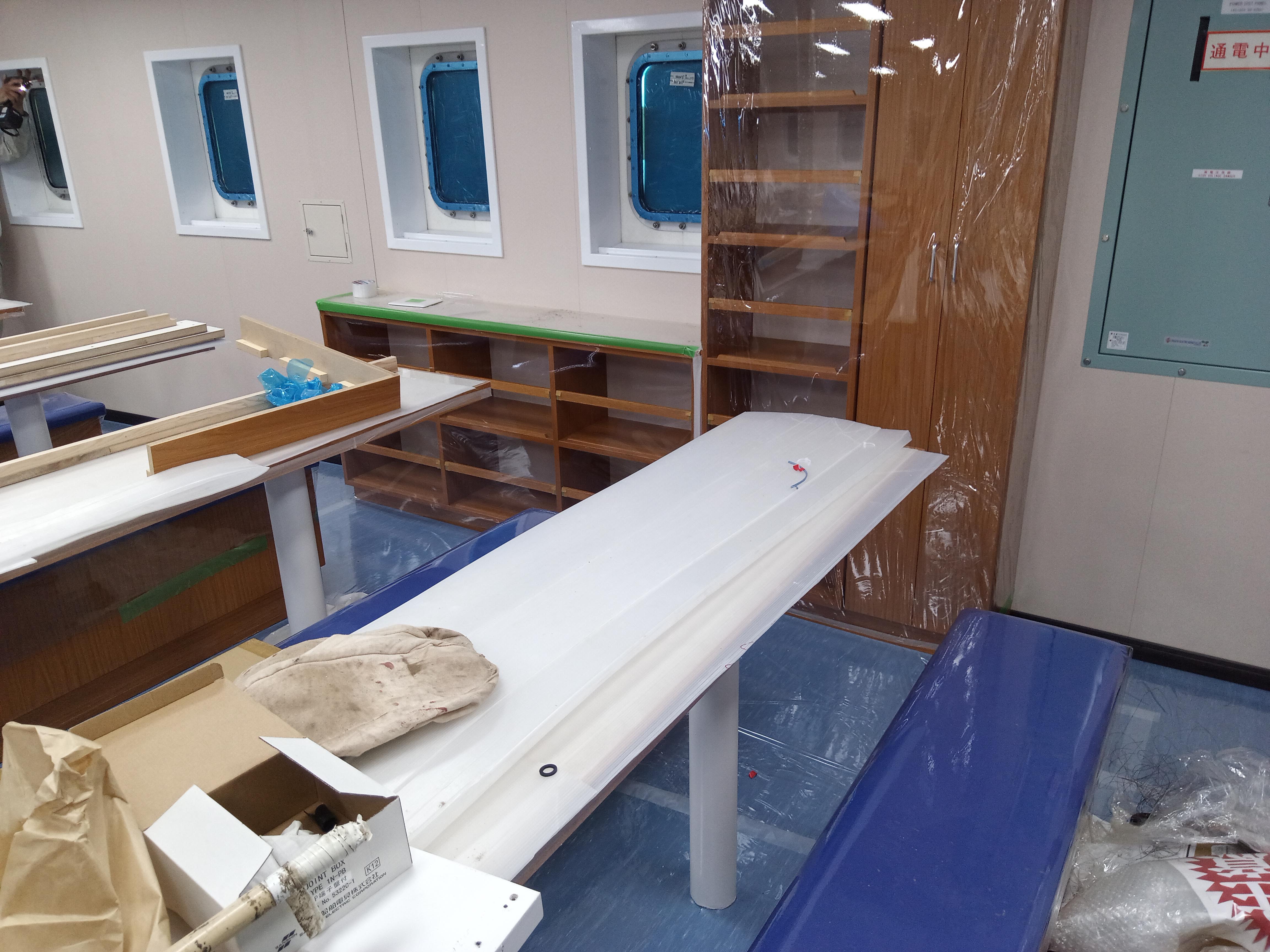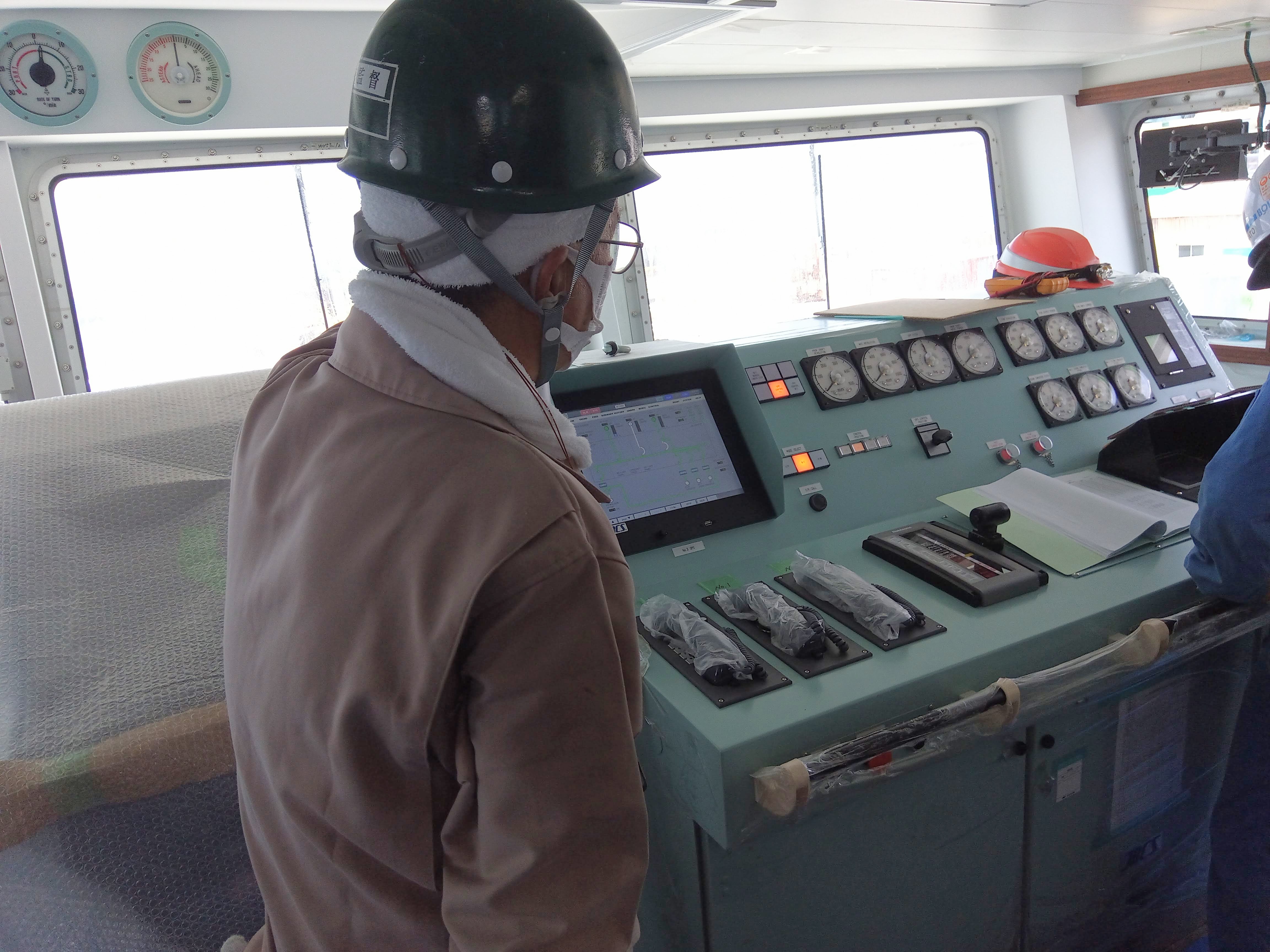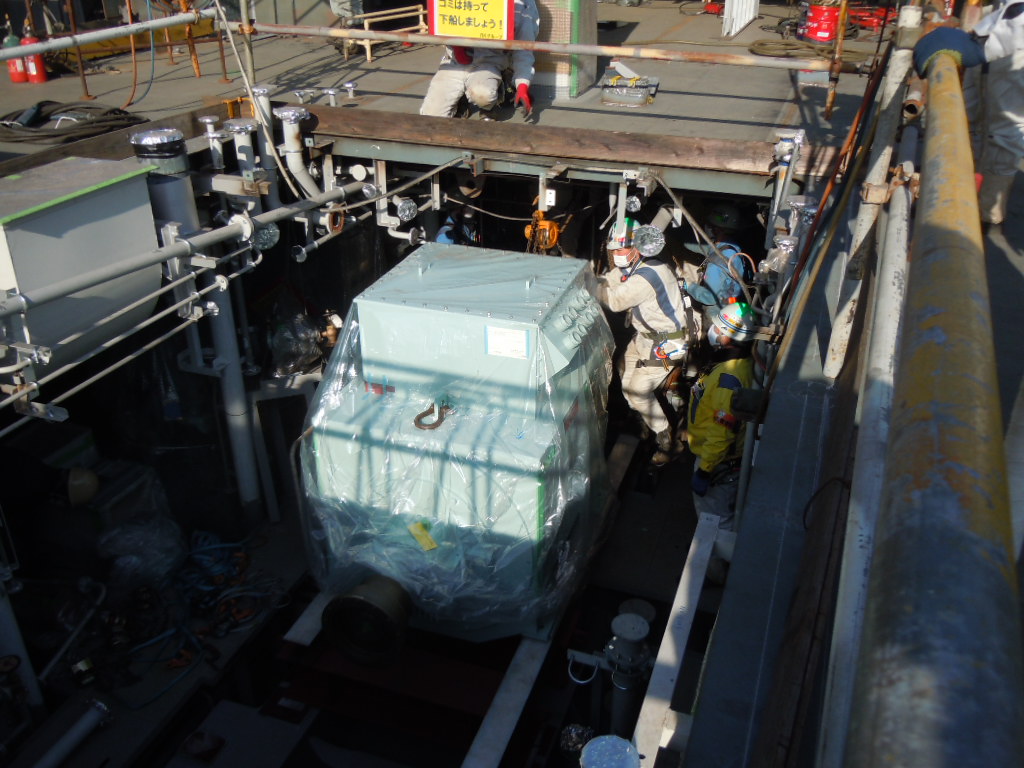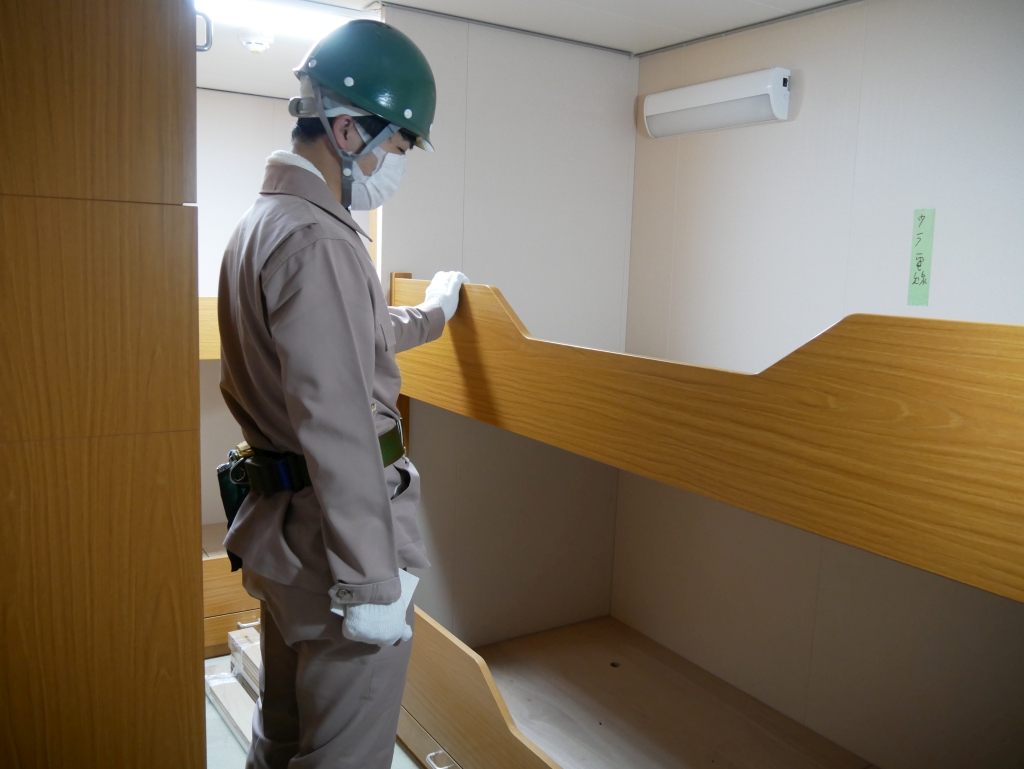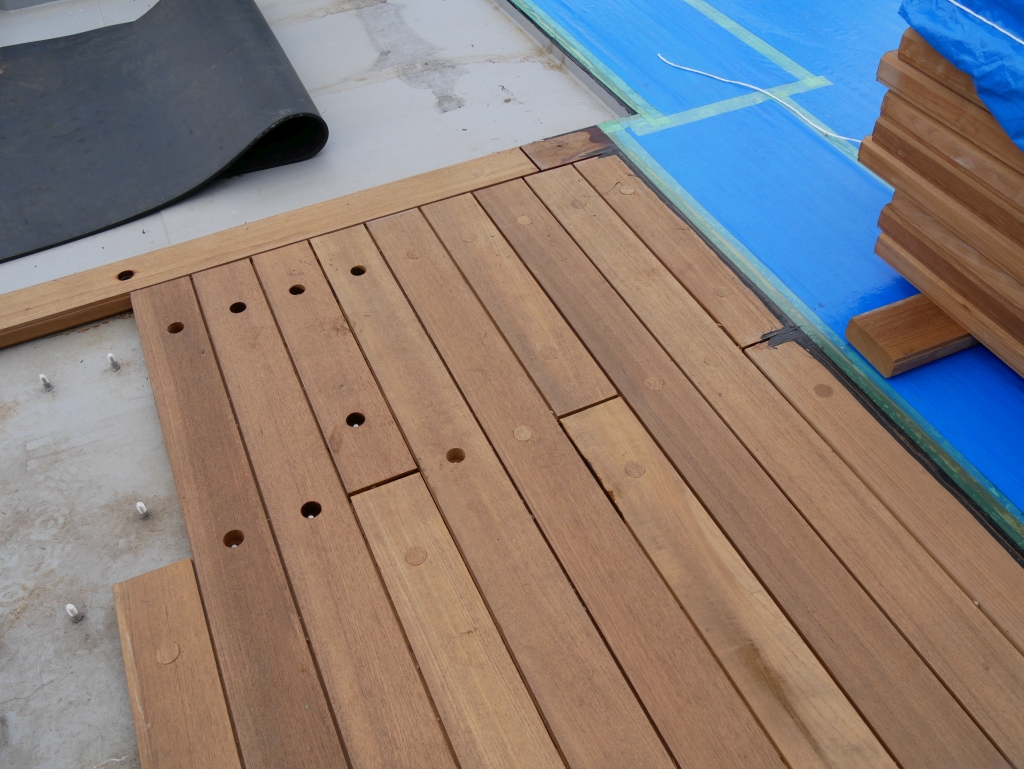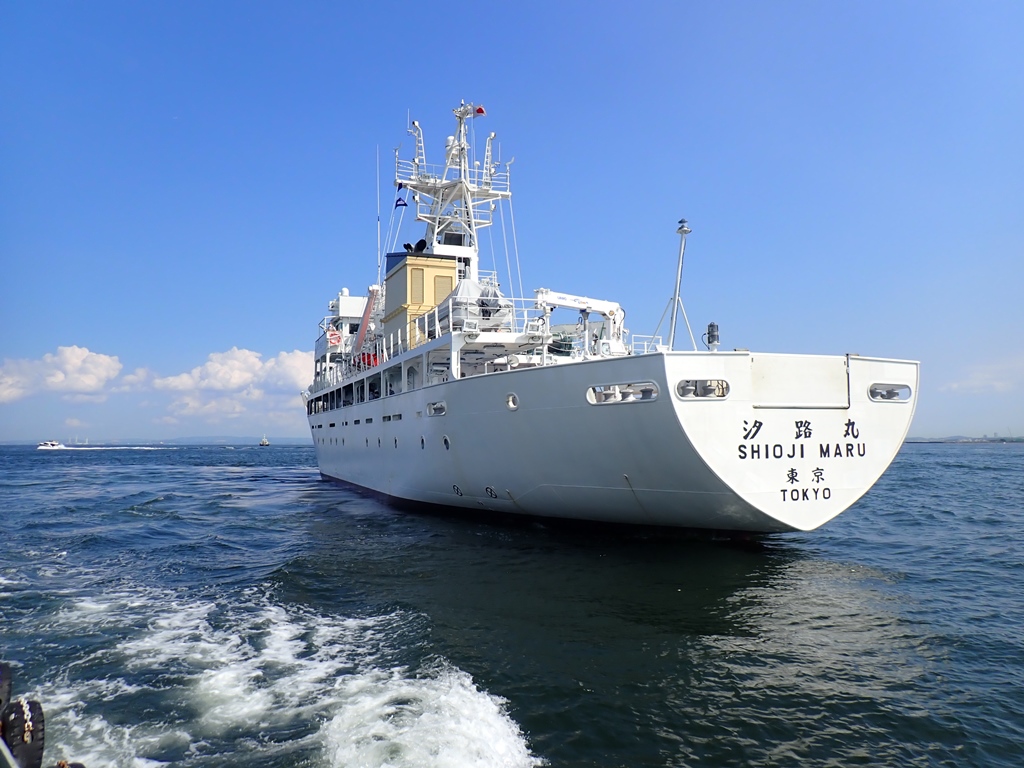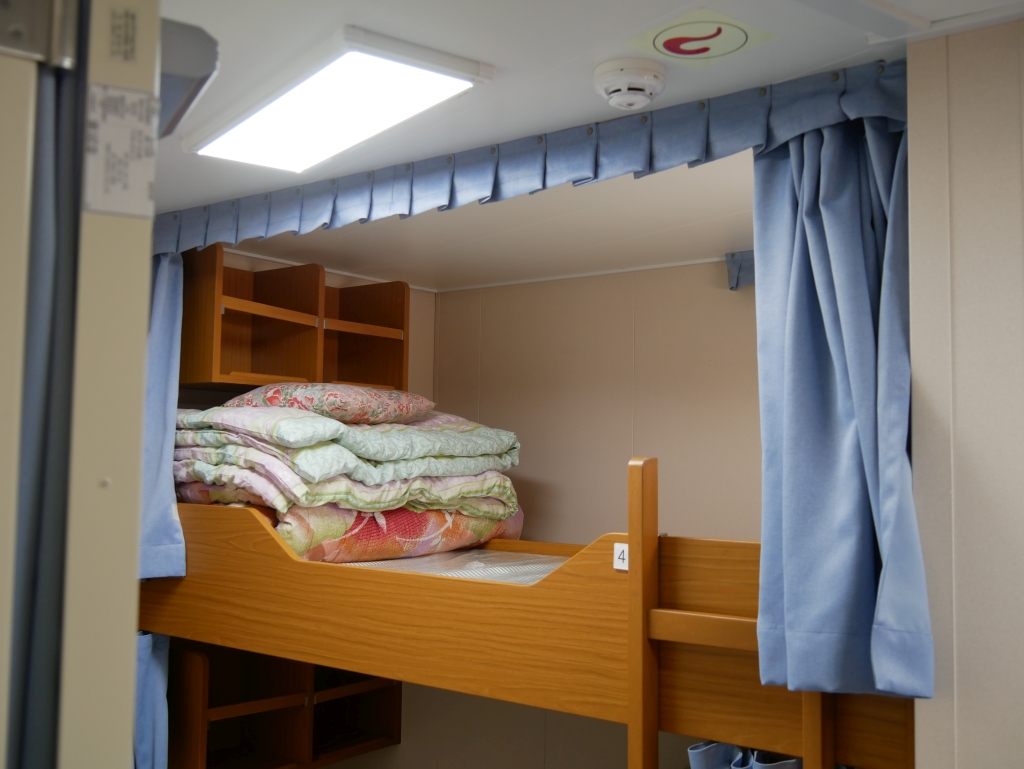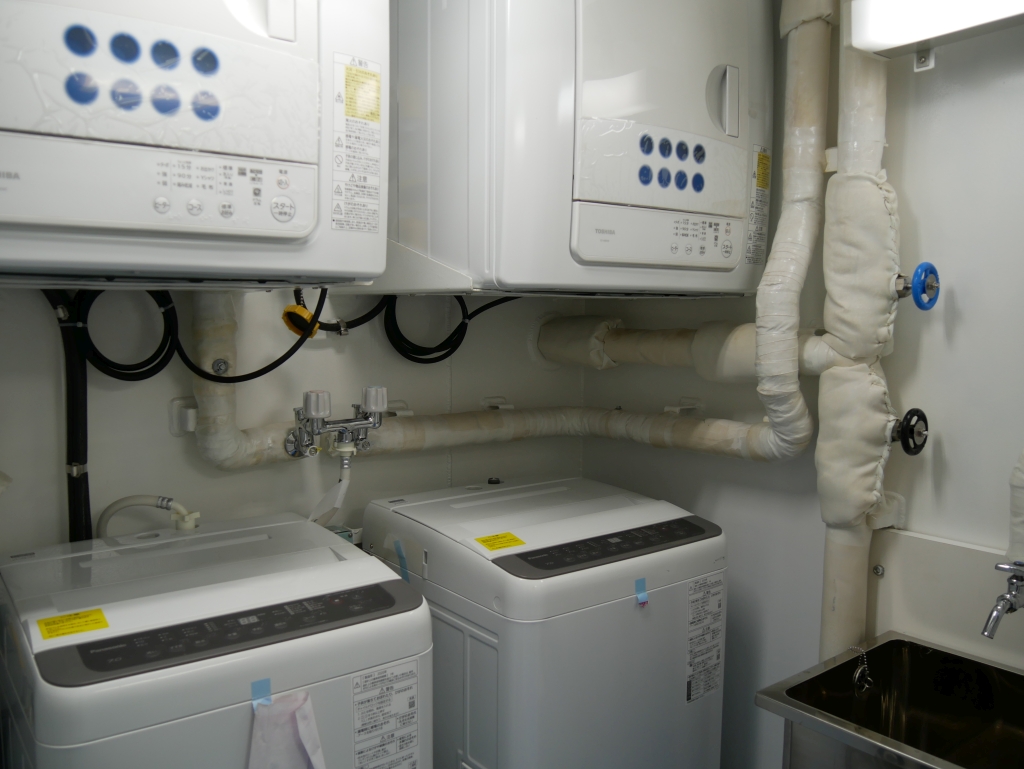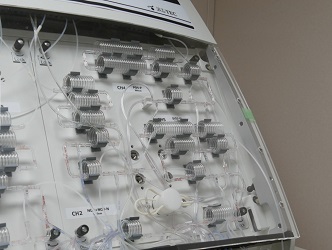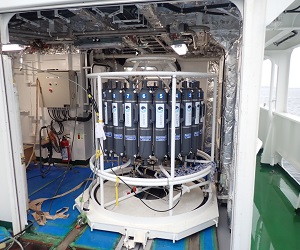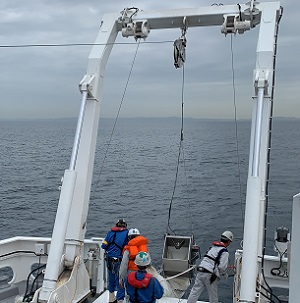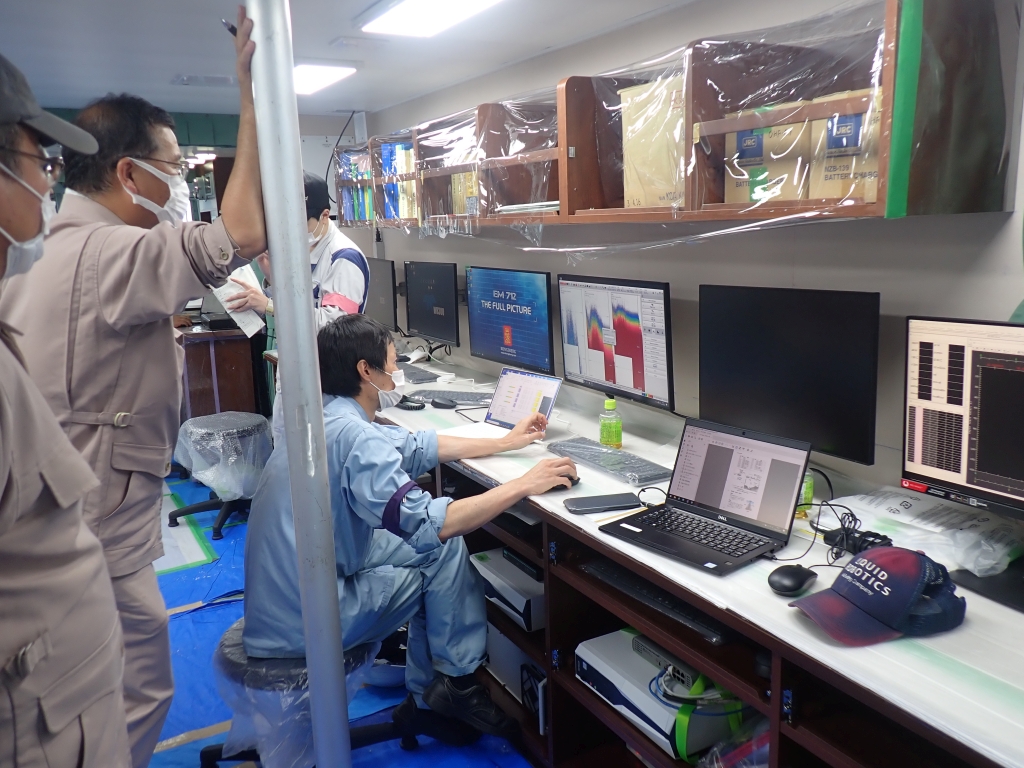In order for Tokyo University of Marine Science and Technology to realize new efforts to develop human resources for marine development, we will integrate the functions of ship personnel training and marine environment education that were carried out by the predecessors Shioji Maru and Seitaka Maru, The Shioji Maru IV, which also has educational and disaster support functions, was built and started operating at our university on October 3, 10.In addition to the functions of the two vessels mentioned above, the new Shioji Maru is equipped with the latest marine environment observation equipment.
The vessel is designed for advanced marine science and technology education, training for prospective seafarers and marine resource professionals, and research activities in marine biology and oceanography. It's a ship.
1. Meeting in the director's office
Meeting in the supervisory room in the shipyard.The greatest key to building a good ship is the accumulation of detailed communication between the shipowner (Tokyo University of Marine Science and Technology), who is a member of the building committee, and the shipyard engineer.
2. Block inspection
We inspected two double bottom blocks near the bow of Shinshioji Maru.I crawl on all fours through a maze-like space covered with steel plates and carefully check the welds.
3. Stern thruster inspection
A stern thruster is a special propeller that moves the hull laterally.The operation test was conducted at a propeller manufacturer (Nakashima Propeller) in Okayama.
4. Block construction of bulbous bow
Construction of the bulbous bow (the very tip of the ship) block is progressing steadily.Thick iron plates are processed into beautiful phases and joined together.It is an important block where the greatest pressure is applied when the ship moves forward.
5. Main propeller
Shin Shioji Maru's main propeller is finally here. A 4-blade variable pitch propeller. By changing the angle of the four blades (see the stern thruster page for more information), it is a convenient propeller that can smoothly switch between forward and reverse without reversing the propeller rotation direction.
6. Propulsion motor
A performance test was conducted on the electric motor that drives the propeller.We will experimentally confirm that it can operate without abnormalities even if we apply speed and force that are impossible in normal operation, and that it will not break even if high voltage is applied.
7. Witness test (inverter)
After completing the inverter set to be installed, we visited Taiyo Denki in Gifu Prefecture to check its performance.The panel is full of inverter modules, circuit breakers, contactors, and various control devices.It looks plain at first glance, but it is an irresistible device for enthusiasts.
8. Sonar dome and tightness test
The Shinshioji Maru will be equipped with many observation instruments that measure various marine environments.Those sensors are placed in a sonar dome that protrudes from the bottom of the ship.
A pressure gauge is attached to the bottom right of the photo. Check if the airtightness inside the sonar dome is maintained or if there is no pressure drop by filling the inside with air.
Also check for air leaks from the welded area with soapy water.
9. Witnessing of measurement and adjustment Main engine
Assembly of Shin Shioji Maru's main engine (main engine: engine for propulsion) has been completed, and adjustments related to operation are progressing.After this, further adjustments will be made, and a land test (pre-shipment inspection by the engine manufacturer) is scheduled to be held in December.Once the land trials are complete, the engines are painted, etc., and preparations for shipment to the shipyard finally begin.
10. Witness test of main switchboard
A switchboard is a facility that safely distributes power from a generator to various electrical equipment on board.It looks plain, but it is a very important facility.The performance test was carried out at the factory of JRCS in Yamaguchi Prefecture.
11. Witness test for line haulers
Ocean observation equipment, etc., may be suspended from strong wires and lowered to depths of 800 to 1000 meters.A line hauler is a device that pulls up pieces of the unknown world captured by observation equipment.
12. Witness test of engine control panel
The engine control panel controls a large-scale system including a large engine and constantly monitors its operating conditions in detail.Nothing in this world is perfect, and no machine is indestructible.That's why the world is lovely.Such an engineer's spirit does not miss even the slightest change in the engine or peripheral equipment.
13. Windlass Witness Test
Ships don't just power through the sea.Sometimes anchors (also called anchors) are lowered to the seabed to rest on the sea.The anchor and its chain are so heavy that they cannot be hoisted easily.That's where Windlass comes in.Lightly pull up the anchor stuck in the seabed.
14. Witness test of reducer
Witness test of reducer was conducted at Hitachi Nico Transmission's Omiya Works.Shiojimaru IV uses both the main engine (propulsion engine) and the electric motor (propulsion motor) to obtain propeller power, so gears that match the speed of each are built into the reduction gear.It is an important component that receives the hot power from the main engine and electric motor and turns the propeller while clenching your teeth.
15. Construction around the main engine in the engine room
Installation of metal fittings to support equipment around the main engine at the bottom of the engine room is progressing.The trapezoidal frame in the center of the photo is a stand for mounting the electric propulsion unit.The place where the workers are standing above is the platform for the main engine, and the bottom of the red tool box on the left is the platform for the generator motor.
16.Witness test of CTD winch
A CTD is an indispensable device for oceanographic observation to measure the electrical conductivity, temperature, and water depth of seawater.The CTD winch is a device that lowers and raises this to the specified water depth.Research to understand the ocean is only possible when these seemingly humble devices work properly.
17. Witness test of A-frame
A-frames are a type of large crane installed on the stern and are often seen on survey ships.It is used to tow underwater biological resources and large equipment used for submarine resource surveys, and to lower/retrieve underwater exploration robots.Shioji Maru I-III, who have long been involved in "nautical practice" and "research and development of new technology".The equipment that impresses that the mission of "marine research" has been added to the Shiojimaru IV, which inherits that history, is the A-frame.
18. Bottom tank
Large engines, generators, electric motors, heat exchangers, air compressors... The engine room is crowded with such large equipment.Underneath it is a tank for storing fuel oil and lubricating oil.There are many walls in a narrow space to keep the strength of the hull.Someday the tank will echo with the sound of machines and waves.Now a dark and quiet space awaits the time to set sail.
19. Witness test of crustal deformation observation equipment
As you know, the area around Japan is a hotspot where the Pacific plate, Philippine Sea plate, Eurasian plate, and North American plate collide.Even if you can't see it, the Japanese archipelago is moving little by little due to plate movement.The instrument that observes the movement speed of this plate is the crustal movement observation device.Shiojimaru IV will also contribute to cutting-edge research to elucidate the mechanisms of the Earth.The photo shows the part called the acoustic transducer, which is part of the crustal movement observation device.In addition, the part that controls DA/AD and the part that controls and records is set up in the observation room.
20. Main engine
Finally, the main engine of Shiojimaru IV was completed, and performance confirmation tests were conducted at the factory of IHI Motor Co., Ltd. in Gunma Prefecture.I was a little surprised by the smaller body than I expected for the power.You will fall in love with the mechanics of the polished and tempered steel body.Perhaps the reason why I feel more "life" than any machine I've seen so far is because of the engine's heartbeat caused by the explosive combustion of fuel.The day when this heavy bass will be the breath of the Shiojimaru is approaching.
21. Main Generator Witness Test
At the Amagasaki factory of Yanmar Power Technology Co., Ltd., we conducted a witness test of the main generator.The main generator is the power source for all electrical equipment on board, and also plays an important role as a lifeline.It is a dutiful device that outputs a constant voltage and constant frequency under any load condition.The main generator consists of a diesel engine and an alternator, driven by mechanical and electrical engineering.The exhaust heats up the surroundings, but it's also a device that warms the engineer's feelings.
22. Block loading
The hull blocks that have been made little by little are mounted on the slipway, and the shape of the ship is starting to form!
Iron slugs weighing dozens of tons are hoisted by giant cranes, picked up with an accuracy of several millimeters or less, and then joined together.The careful work and meticulous care of the shipyard engineers bring the steel plates to life.
23. Equipped with main engine
Finally the main engine was installed.Surprisingly small body, but enough power.It is a reliable and proven model that creates a stable propulsion force for the Shin Shioji Maru.
24. Propulsion motor installed
The electric motor that plays a role in the propulsion power of the Shinshioji Maru was installed in the engine room section.
It looks like a small body, but it creates propulsion when observing the ocean.
25. Equipped with reducer
The energy produced by the main engine is converted into high torque through a reduction gear.This force drives a large propeller, and the large hull gains propulsion.
26. Shaft generator installed
A shaft generator is a special generator for extracting the power of the main engine as electric power.It provides plenty of power for the thrusters that drive when entering and leaving port.
27. Part of the hull is made of aluminum!?
Generally, large ships are built with thick steel plates welded together so that they will not break even when hit by rough seas.The parts of Shinshioji Maru that come into contact with seawater are also made of steel.On the other hand, by using aluminum plates for structures above sea level, it is possible to reduce weight and increase stability.The aluminum before painting looks shiny and clean, but it is difficult to weld, so the work is proceeding carefully.
28. Wait for Windlass
Previously introduced "
13. Windlass” (a powerful device for hoisting a huge anchor) will be installed here.It's a stand without any quirks, but it's an important position to protect the safety of the ship.
29. Funnel
The funnel is the part where the exhaust gas from the main engine and the generator engine is collected, so to speak, it is a collective chimney.The funnel is not only a chimney, but also an important element that gives individuality to the appearance of the ship.
30. Emergency generator
In the unlikely event of a power outage, not only will the ship become pitch black, but the communication equipment necessary for navigation will also become unusable, which is dangerous.Even in such a situation, this emergency power generator quickly supplies power to wireless equipment, steering gear, etc.It's best that he doesn't have a turn, but Iza is a guardian deity when he's crouching.
31. University name paint
Finally, some parts of the superstructure (the parts not in contact with sea water) have started to be painted.The blue Tokyo University of Marine Science and Technology logo stands out on a refreshing white background.
32. Load line marker installed
Draft is the depth of a ship's hull below the surface of the water.A ship's draft can be shallow or deep depending on the weight of its cargo and the temperature of the seawater.The load line mark is a mark that indicates that there is no problem in voyage safety even if the hull is submerged in seawater until the water surface reaches this point.
33. Water tightness confirmation by high-pressure water discharge
When the sea waves are high or when the hull rolls heavily, the lower windows of the hull may momentarily go below the water surface.Tests were conducted to ensure that water would not come in through the windows when the water pressure was applied.Of course, even if high-pressure water is injected directly, it will not move.
34. Sacrificial electrode
The hull is made of thick steel.Since it is in constant contact with seawater, it is destined to rust little by little if left unattended.The sacrificial electrode plays an important role in stopping this.In university lectures, we also learn about this principle.
35. Radar mast
Knowing exactly what is going on around your ship is essential for safe navigation, even in the thickest fog or pouring rain.At the highest part of the ship, called the mast, various types of state-of-the-art radar equipment and measuring equipment are arranged cramped together.
36. A scrutiny was made
The ship is designed so that even if it tilts due to the effects of waves and wind, it will naturally exert a force to return to its original position.Checking this performance is the juusa. A 2-ton heavy object is moved on the ship, and the tilt at that time is measured with a precision machine, and calculations are performed.
37. Naming and launching ceremony held
On March XNUMX, XNUMX, the naming and launching ceremony of the training ship Shin Shioji Maru was held at the Isogo Factory of Japan Marine United Corporation. →
Please also check this page.
38.A60 firewall
The ship, like the building, has fire walls everywhere to prevent fires from spreading throughout.This will prevent burnout. The A60 firewall is designed so that even if a fire breaks out in the next block, the flames and smoke will not penetrate through it for at least one hour.A special insulation is applied to prevent the wall temperature on the non-flame-exposed side from rising excessively.
39. Wires, wires, wires!
The Shinshioji Maru will be equipped with the latest equipment.Propulsion motors, thrusters, measurement equipment, analysis equipment, observation equipment, cooling equipment, heating equipment, centrifugal separators, pumps, air compressors, radar, communication equipment, steering equipment, air conditioners, lighting, cooking equipment, sewage treatment equipment, manufacturing Water devices, vast sensor devices... they all require power and are connected by wires.A large amount of electric wires will be installed in inconspicuous places such as walls, floors and ceilings.
40. Voyage Funabashi
This is Saikai Funabashi.Various control devices, wireless communication devices, radars, etc. necessary for the safe operation of the ship are installed.Of course, various sensor information for grasping weather conditions and hull conditions is also aggregated.
41.Engine control room
This is the engine control room.This is a centralized monitoring and control command room where you can grasp the operating status of all machines and devices installed in the engine room.The generator control panel can be seen in the back right, and the engine monitoring control panel in the front left.
42. Mooring
The Shinshioji Maru has been floating in the sea since it was launched in March.She is moored with several thick ropes (also called hawsers) during the interior work (also called rigging work) to prevent her from being washed away by strong winds and rain or hitting the quay.
43. Munsell 7.5BG7/2
Many of the large equipment installed on ships, including engines, are painted pale green as shown in the photo.In particular, the color called "Munsell 7.5BG7/2" is often used.When I introduced the main engine before, it was painted red, but now it has been redecorated to pale green and is installed in the center of the engine room.This shade seems to be preferred and used because it is less irritating.
44. Insulation
The hull is made of steel plates.Parts exposed to sea water and the outside air become considerably cold in winter.Insulation is applied in various places so that the warmth inside the ship is not spoiled by this.Insulation is used extensively, especially in living spaces.
45. Thermal Insulation -Part XNUMX-
The temperature in the engine room increases while the large main engine or generator engine is running.On the other hand, since the outside of the wall is sea water, the air near the wall is considerably cooled.If this causes a lot of condensation in the engine room, it can cause a variety of problems.In addition, if the heat in the engine room is directly transferred to the living space inside the ship, cooling becomes difficult.Therefore, special insulation is applied to the ceiling and walls of the engine room.At the same time, it also makes it difficult for loud engine sounds to be transmitted.
46. ??Attic
Behind the ceiling plate of the engine control room, thick electric wires run freely.It is a masterpiece that thick electric wires are laid in multiple layers in an orderly and dense manner.
47. Confirmation by the crew of Shiojimaru
The construction status is also checked by the current Shioji Maru crew, who are specialists in ship operation.On this day, the captain, first officer, and first engineer inspected the walls of the student room, the wiring in the ceiling, and the installation status of various devices.
48. Floating Dock
Shiojimaru, which is currently under construction, is in a floating dock.A floating dock is a large concave structure that can float and sink.If you put a huge amount of seawater in the tank, it will sink leaving about half of the walls on both sides.Lead a floating ship there.After that, when the seawater in the tank is discharged, the floating dock itself floats along with the ship introduced.After launching, seaweed and shellfish that adhere to the bottom of the Shiojimaru are removed.
49. Crane operation check
The vessel is equipped with a crane with a reach of 10m, and its operation was confirmed. The operation of lifting and moving a weight of 0.95 tons was repeated, and it was confirmed that it was normal.
50. Classroom
Classrooms onboard were fitted with long white desks and bright blue bench seats.By installing multiple square windows around the classrooms, it is possible to take in a lot of natural light while maintaining the structural strength of the hull.
51. Control operation check
The ship is equipped with a total of three side thrusters.These were activated on the bridge and it was confirmed whether the power could be controlled normally.The first sea trials are finally next week.The working condition of every piece of equipment has been carefully checked.
52. Load test of shaft drive generator
[Video] State of the main engine when driving the shaft (YouTube).
A load test was conducted on the shaft-driven generator (commonly known as the shaft generator) on board the Shinshioji Maru.The shaft engine is driven by the main engine, and it is a powerful device with horsepower second only to the main engine onboard.As a power supply source for the thrusters, it is effective mainly when entering and leaving port.
53. Bonk
A bonk is a ship's term for a bed.Each student's room is equipped with wooden bins and shelves in subdued colors.After this, the mattress is put in and the curtains are installed.
54. Wooden deck
One of the characteristics of the research and training ship is this wooden deck.Unlike "flooring" found in ordinary homes, it can withstand exposure to strong UV rays and sea water.It is spread out as a floor material for outside passages and work spaces.
55.Finally Sea Trials
Finally, the sea trial of Shin Shioji Maru started.It is built according to the specifications and undergoes test voyages four times (a total of 4 days) to confirm that it can demonstrate its performance.Everything has been confirmed, from important equipment such as navigation instruments, ship handling performance, engines and generators, to observation equipment, air conditioning, cooking rooms, shower rooms, and toilets.
56. Curtain
Bonk (ship's term for bed) friendly color curtains were installed.From the time I cut the iron plate and started assembling it, it has begun to become a living space that is unimaginable.
57. There is also a washing machine
When I board a ship for experiments, practical training, or research activities, I sometimes spend many days at sea.Of course, we need a washing machine in our daily lives.There are separate laundry areas for women and men.
58.Automatic nutrient analyzer
(auto analyzer)
This device accurately measures the concentration of nutrients such as nitrogen and phosphorus required for the growth of phytoplankton in the sea.Photosynthesis of phytoplankton is closely related to global warming and trends in fisheries resources, and accurate analysis of the nutrients that drive it is particularly important.It is planned to be very active in practical training and research related to oceanography.
59.CTD
One of the essential devices for ocean observation.A dedicated crane is used to swing it overboard and unload it into the deep sea. CTD is an abbreviation for Conductivity Temprature Depth profiler, which means a device that measures electrical conductivity, water temperature, and water depth.A marine scientist's partner who draws out the unknown world in the sea.
60. Multi-stage openable net (MOCNESS)
operation test of
What is the relationship between the depth of the sea and the type and amount of plankton?Understanding this is important for marine biology.This multi-stage retractable net can be opened and closed at various depths, enabling a detailed understanding of plankton distribution.
61. The 4th sea trial is over!
All four sea trials were successfully completed.At the XNUMXth meeting, we carefully checked the operation of the special marine observation equipment and high-sensitivity sensors installed on the ship.Although the time is limited for the completion and handover next month, not only the engineers of the shipyard and the manufacturer, but also the Shiojimaru crew members and the teachers in charge of construction are working together to make adjustments. .







